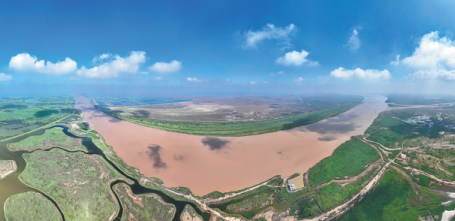Digital technology used to assist Yellow River's ecological protection
Updated: 2023-08-04

The Yellow River about to empty into Bohai Bay in Dongying, Shandong province. [Photo by Wang Yuzhang for China Daily]
Major media outlets from nine provinces and autonomous regions along the Yellow River, including Shanxi, gathered in Shandong province to learn about its use of digital technology to enable high-quality growth and ecological protection.
The 5,464-kilometer Yellow River, originating from the snow-capped mountains in Qinghai province and emptying into Bohai Bay in Shandong's Dongying city, is the second-longest river in China. It is regarded as the mother river of the nation because it has nurtured Chinese civilization for millennia.
To protect the ecology of the Yellow River drainage basin and benefit local residents with sustained growth, the Central Committee of the Communist Party of China and the State Council issued a guideline on the ecological protection and high-quality development of the Yellow River drainage basin in October 2021. It kicked off a large-scale campaign for the region's sustainable development.
Shandong, the last province along the river, is one of the pioneers in using digitalization to assist environmental protection of the river and sustainable regional development.
The media tour's first leg was in Jinan, the provincial capital of Shandong, on July 25, where they visited the National Supercomputing Center Jinan.
Boasting a platform consisting of thousands of supercomputers, the center offers digital services to businesses, governments and communities in Shandong and beyond.
Assisting the high-quality development of the Yellow River drainage basin is one of the major missions of the Jinan center. The center cooperated with 10 computing institutions along the river to establish a Yellow River Computing Network Alliance in Jinan in March with the aim to inject vigor into the high-quality growth of the river region.
Another example of digital technologies being used for environmental protection is the Yellow River Delta National Ecological Protection Zone, located at the river's estuary in Dongying city.
When the journalists visited the zone's ecological monitoring center on July 27, they were impressed with its powerful land-sea-sky monitoring system.
The monitoring room features dozens of display screens showing areas of the park. A staff member at the center said that the images are collected by sensors and cameras scattered across the estuary, or from drones in the sky and even satellites.
Qiu Xuanmei, a tour member from Gansu Daily in Gansu province, said he was amazed at the center's bird identity technology.
"Every detail of the birds is shown on the screens, as if they are just meters away," Qiu said. "That is the power of the latest technology in computing and algorithms."
In Shandong, digital technologies are widely used in business operations and governance.
Niulan Diheniu Food is a company in Zibo city engaged in beef cattle farming. Digital technologies are used in the whole process of its operations, according to Dong Guan, an executive of the company.
"From birth to the dining table, every head of cattle of ours is traceable with the help of digital technology," Dong told the visiting journalists. "This makes strict quality control possible and brings higher added value."
He added that beef cattle from his company can sell at more than 100,000 yuan ($13,920) each, a price much higher than others on the market.
Digitalization is also playing an increasingly important role in local governance. According to Sun Qisheng, head of the Shandong Big Data Bureau, 72 percent of Shandong's county-level regions are governed with digital assistance and there are more than 1,200 "smart communities" provincewide.
Li Quanhong contributed to this story.



